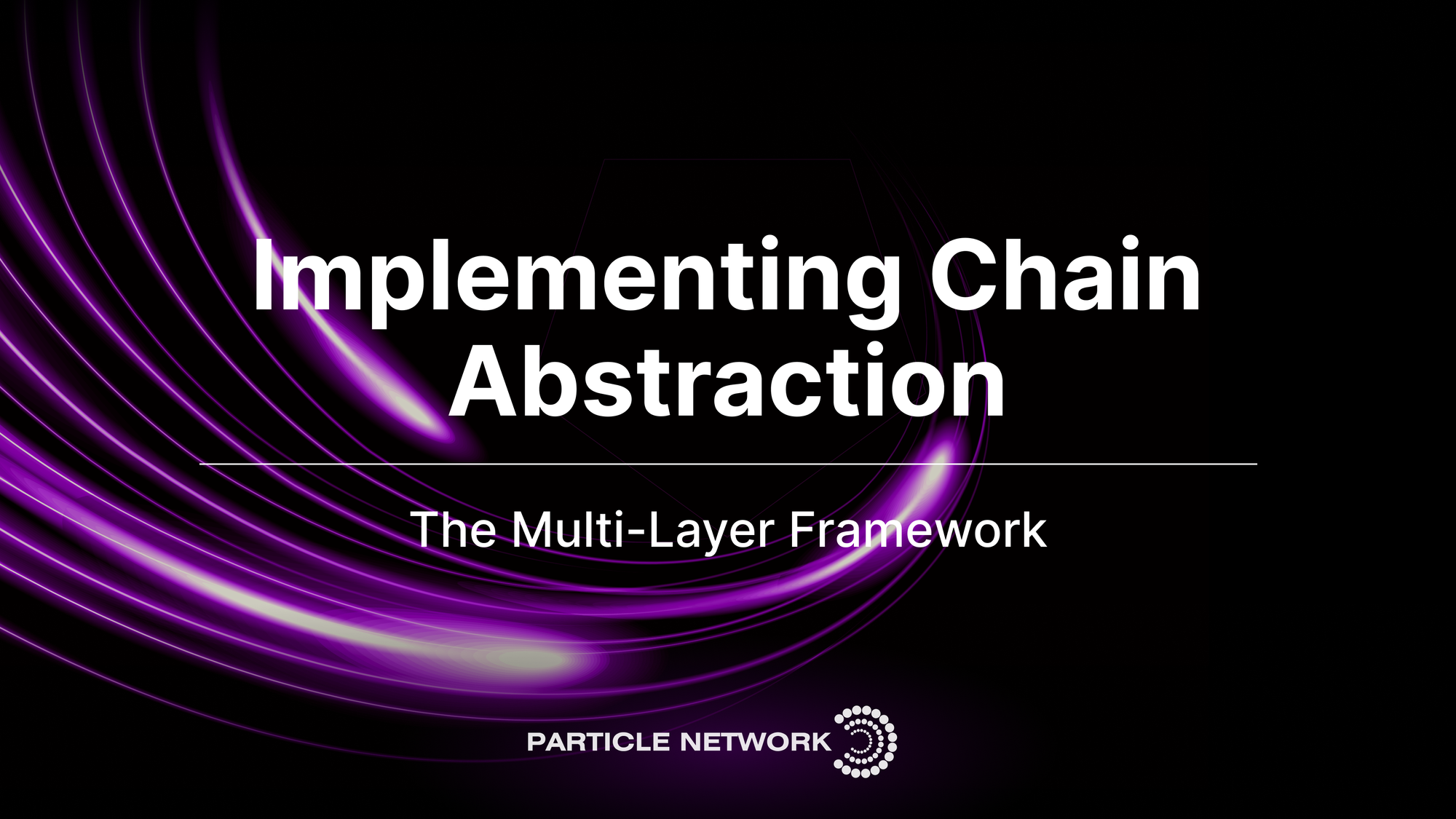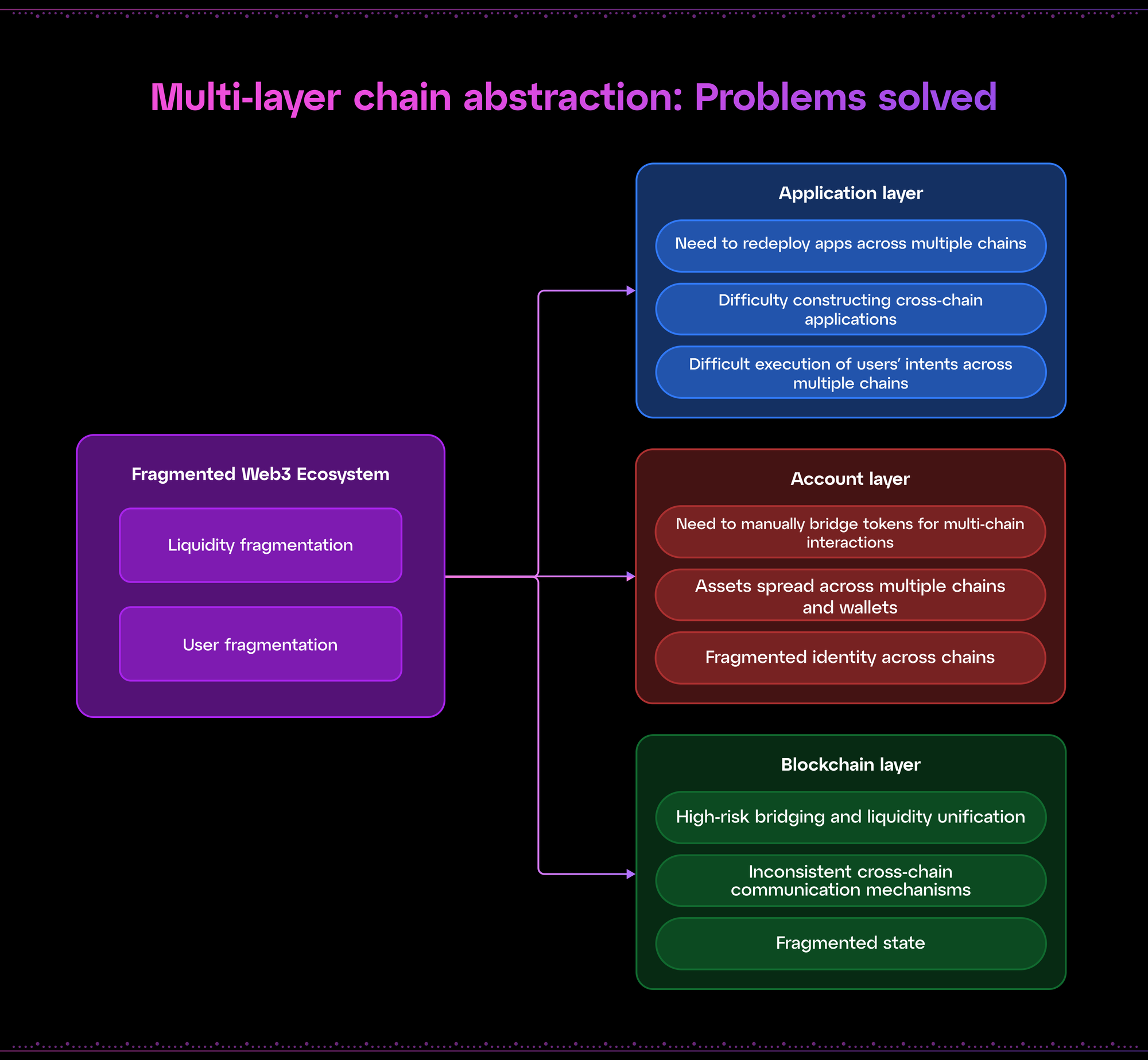Implementing Chain Abstraction: The Multi-Layer Framework

Table of Contents:
Chain abstraction can only be achieved through multiple layers of technologies.
As this vertical develops, it becomes clearer that chain abstraction is, rather than a technology, a multifaceted approach to simplifying the user experience of a fragmented ecosystem. This can be observed clearly, with multiple projects attempting to achieve chain abstraction across different Web3 applications and infrastructure.
Within this novel field’s theoretical framework, multiple ways to understand the role and involvement of various participants of chain abstraction have arisen. In this article, we will formalize the multi-layer framework. This framework, previously introduced in the article “Chain Abstraction on Multiple Levels: Diverse User Experiences Inside Web3’s Evolution”, aims to present a way of understanding the chain abstraction ecosystem through the roles different services and products play based on their resulting user experience.
–Special thanks to the teams at XION, Agoric, and SEDA for their input on this piece.
Multi-layer framework: Goals and importance
The goal of having a multi-layer framework for chain abstraction is to provide a structured and comprehensive way of understanding the multiple approaches to arriving at a chain-abstracted experience. This also seeks to present chain abstraction as multiple layers of technologies that can be stacked to achieve a “total implementation” of chain abstraction –that is, one that spans the entire set of experiences users can encounter within Web3.
Importantly the multi-layer framework relies on the formal definition of chain abstraction (ChA) previously presented, characterizing ChA as "a user experience exempt from the manual processes required to interact with multiple chains."
This definition will be critical to the framework itself since, as to better classify chain abstractions’ participants, the vertical needs to be understood as an experience– one that might (or not) be found in different aspects of users’ Web3 interactions, with various solutions working together for a complete implementation.
As such, this framework takes into account the following:
- The various solutions that abstract away the complexities of interacting with multiple chains from users’ experience.
- The diverse ways in which these different components and solutions can work together in a modular and complementary manner to create a seamless, unified chain abstraction user experience across multiple blockchains.
- The emergent nature of diverse chain abstraction solutions organically developing, each serving different, real needs of users and developers.
Introducing the multi-layer framework
This framework consists of three levels, each enabling the experience of chain abstraction through a variety of possible user activities and existing experiences.To be categorized within this multi-level framework for chain abstraction, a project or solution must aim to address one or more aspects of the user experience across multiple blockchains. The specific criteria for inclusion in this framework are:
- The solution should target end-users, developers, or both, with the goal of simplifying their interactions and workflows across different chains.
- The solution should result in a tangible benefit to the user experience, regardless of the level it targets. As such, solutions that only partially achieve chain abstraction but are nonetheless valuable for achieving chain abstraction might be better covered by other frameworks, which will be discussed at a later section.
Having stated our ground rules, the framework itself categorizes projects as follows:
Application-level chain abstraction (Orchestration)

The application-level layer, also known as orchestration, focuses on empowering developers to create decentralized applications (dApps) that can seamlessly span and interact with multiple blockchains. This layer comprises:
- Low-level software development kits (SDKs) and application programming interfaces (APIs), which serve to orchestrate cross-chain workflows and operations within dApps.
- Frameworks for building chain-agnostic applications.
- Solver and intent networks that translate users’ goals into multi-chain pathways, materialized through SDKs applied at the application-level
By providing these developer-centric tools and abstractions, the application-level enables:
- The creation of applications that can coordinate and execute transactions across distinct chains through a single user-level signature.
- The implementation of asynchronous, long-running business logic that spans various blockchains allowing for enhanced interoperability and flexibility within dApps.
- The abstraction of the underlying multi-chain complexity, allowing developers to focus on application-specific functionality.
The application-level layer could be considered mandatory for a complete chain-abstracted experience, as it complements the user-focused account-level solutions by extending the abstraction capabilities of applications.
Projects like Agoric, Skip, and Socket are at the forefront of application-level chain abstraction, providing developers with the tools and frameworks necessary to build truly chain-agnostic applications. Respectively:
- Agoric's Orchestration API offers contracts and APIs for executing multi-chain transaction flows with a single user signature, simplifying complex interoperable operations.
- Skip provides an API for facilitating seamless cross-chain transactions (swaps, transfers, etc.), aggregating messaging protocols such as IBC, Hyperlane, and Axelar.
- Socket provides an open marketplace for intent execution and settlement, allowing developers to compose with any app and asset.
By leveraging these solutions, developers can focus on creating innovative user experiences without being constrained by the limitations of multiple blockchain networks, thus contributing to the broader goal of chain abstraction at the application level.
Account-level chain abstraction

The account-level layer aims to provide users with a generalized mechanism to seamlessly interact across multiple chains, addressing the fragmentation at the user level. It involves solutions that directly offer users a way to achieve a single balance across multiple chains, with the ability to deploy assets throughout the Web3 ecosystem without manually managing multiple chains. This layer includes:
- Generalized methods of unifying balances across chains and applications.
- Automatization of the multi-chain challenges of gas payments and account interactions, implemented at the account-level.
- Account unification technologies, providing a single identity or point of access for accounts across multiple chains.
By unifying account experiences, the account-level layer allows for:
- Users to maintain a consistent identity and balance across participating chains.
- Transparent and seamless movement of assets between different blockchains.
- A chain-agnostic user experience, where the underlying blockchain becomes an irrelevant, optional detail.
This layer is required for a complete chain abstraction implementation, since it significantly enhances the user experience by abstracting away the need to manage separate accounts and asset pools for each individual chain. This seamless account-level integration complements the infrastructural foundation provided by the other two layers, further facilitating efficient and user-friendly interactions across the Web3 ecosystem.
Examples of account-level chain abstraction solutions include:
- Particle Network's Universal Accounts, providing users with a unified address and balance across chains.
- XION’s chain abstraction solution, aiming to remove all end-user complexities through a variety of abstractions (accounts, signatures, gas, devices, etc.). This is extended through Meta Accounts, which allow central control of assets and accounts on external chains using the XION L1.
- NEAR’s Chain Signatures, allowing for the central control of accounts across chains on NEAR.
- Aarc, unifying accounts, liquidity, and gas markets across 40+ chains through the Aarc Atlas Chain.
- OneBalance, a lower-level primitive enabling “Resource Locks” through Credible Accounts, powering functionality such as balance unification, gas abstraction, etc.
By providing a consistent and unified account experience, the account layer serves as a crucial stepping stone towards achieving a complete implementation of chain abstraction, enabling all users to engage with Web3 applications and services without concern for the underlying blockchain infrastructure.
Blockchain-level chain abstraction

The blockchain-level layer essentially addresses the lack of infrastructural parity between individual blockchains to offer interoperability between them, creating the experience of chain abstraction with minimized risk, latency, and cost. As such, it involves networks or collectives of blockchains that have agreed to share certain properties, including:
- Security mechanisms.
- Cross-chain messaging and bridging capabilities.
- Direct compatibility across chains of the same stack, allowing for high interoperability.
By sharing these features, the blockchain-level layer allows for:
- Easy migration or sharing of state between participating blockchains.
- Providing security guarantees across the collective.
- Enabling efficient cross-chain messaging and communication.
While not a strict requirement for achieving chain abstraction, the blockchain-level layer can significantly enhance the user experience by providing a shared foundation for security, communication, and state management across participating chains. This, in turn, can facilitate more efficient and seamless interactions at the account and application levels, enhancing their functionality and user experience.
Examples of implementations at the blockchain level include Polygon's AggLayer, which aggregates zk-proofs from a collective of chains deployed through Polygon’s stack and submits them to Ethereum for settlement. It also partially encompasses The Cosmos ecosystem, which leverages the Inter-Blockchain Communication (IBC) protocol for cross-chain messaging and interoperability among IBC-enabled blockchains. Optimism’s Superchain is also included within this layer.
Non-applicability
As mentioned above, projects or solutions that do not meet the initially specified criteria or that do not explicitly try to achieve any part of chain abstraction from a user experience perspective can remain valuable to the overall goal of chain abstraction.
These solutions might be better categorized within Frontier Research’s CAKE framework or Everclear's "Chain Abstraction Stack" as low-level, foundational solutions. These frameworks are designed to encompass the technologies, protocols, and primitives that serve as building blocks for chain abstraction solutions, but do not directly target the user experience aspect. Examples of such solutions could include cross-chain messaging protocols, account abstraction primitives, clearing layers (such as Everclear), or intent based oracles (such as SEDA).
Specifically, both above frameworks work as follows:
- The CAKE framework, developed by Frontier Research, is a low-level framework that organizes and unifies the various technologies and solutions that compose chain abstraction. It includes the Permission layer (account abstraction, intents, key management), the Solver layer (cross-chain logic execution), and the Settlement layer (DA layers, bridges, oracles).
- On the other hand, Everclear's "Chain Abstraction Stack" provides a lower-level framework specifically focused on intent-centric implementations of chain abstraction. It outlines the stack of technologies involved in enabling users to execute intents seamlessly across multiple chains through a single interaction.
Both frameworks aim to provide a structured, granular understanding of the various components and layers involved in achieving chain abstraction, but they differ in their focus and scope. The CAKE framework takes a broader view of the technologies involved, while Everclear's stack is more specialized in intent-centric solutions. The multi-layer framework exists multiple degrees higher than these in terms of granularity, purely encompassing chain abstraction solutions rather than the technologies that compose them.

Conclusion
The multi-layer framework offers a new perspective on chain abstraction, categorizing solutions based on their impact on user experience across different levels of the Web3 ecosystem. By distinguishing between blockchain-level, account-level, and application-level abstractions, it provides a structured approach to understanding the diverse and complementary roles of various chain abstraction technologies towards a total implementation.
Industry participants can leverage this framework to strategically position their projects, identify potential collaborations, and guide product development. By understanding where their solutions fit within the multi-layer structure, teams can focus on enhancing specific aspects of chain abstraction while recognizing opportunities for integration with complementary technologies.
This framework also provides a roadmap for investors and researchers to assess the completeness and potential impact of chain abstraction initiatives, ultimately driving progress toward a more unified and user-friendly Web3 ecosystem.

Particle Network's Wallet Abstraction solutions are 100% free for developers and teams. By integrating them, you can set your project in a path to leveraging chain abstraction.
About Particle Network

Particle Network powers chain abstraction, addressing Web3's fragmentation of users and liquidity. This is enabled by Particle's Universal Accounts, which give users a unified account and balance across all chains.
Share this article
About the author(s)


